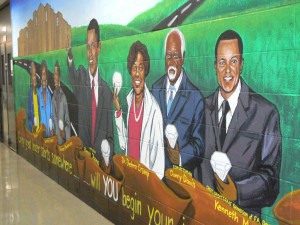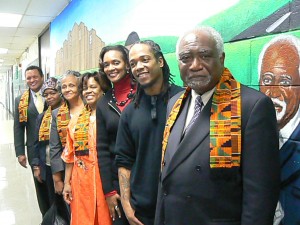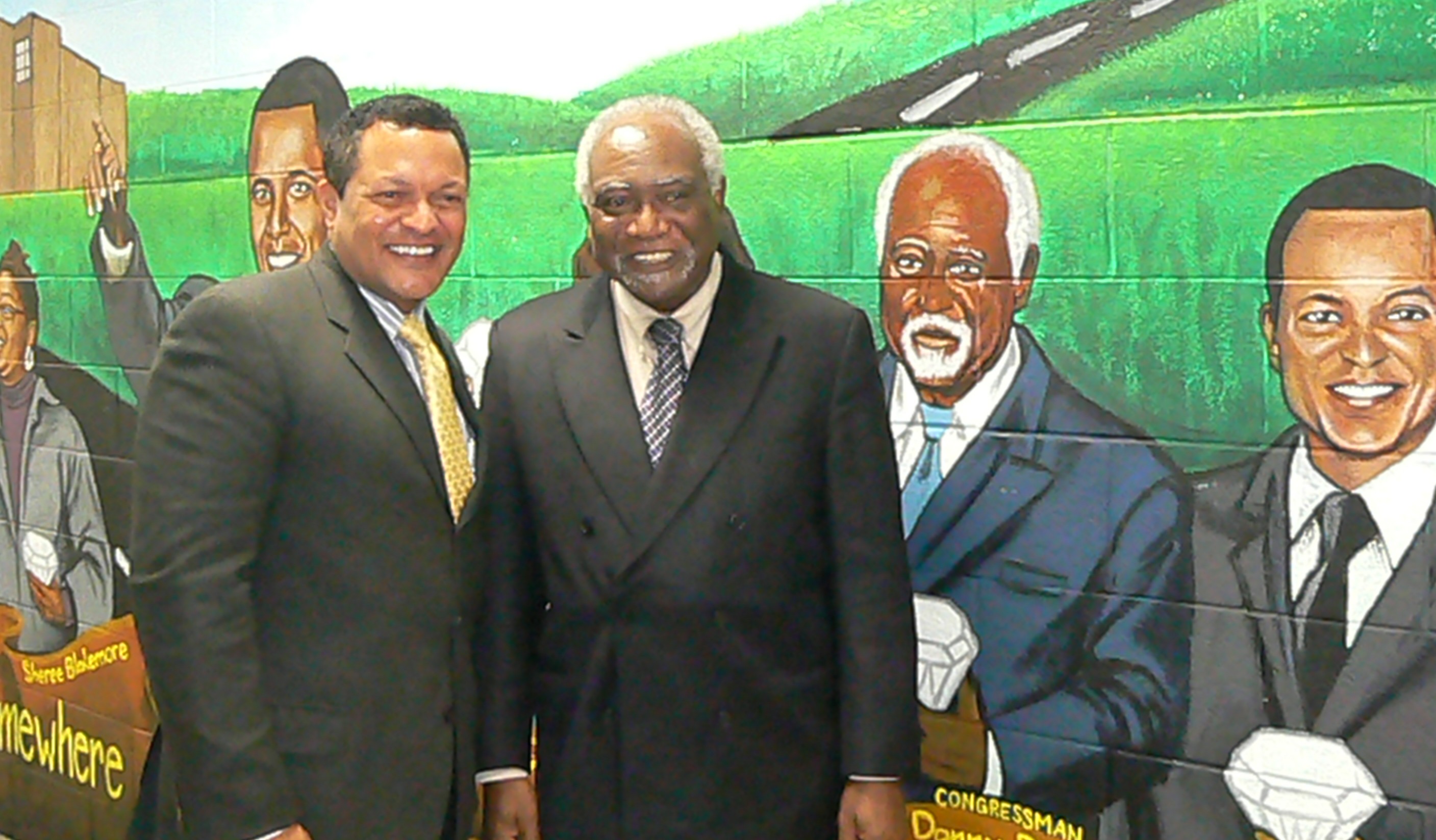By La Risa Lynch
The progeny of a Nineteenth Century abolitionist helped dedicate a new mural at an Austin high school named after his great great great grandfather.
The great great great grandson of Frederick Douglass, Kenneth Morris, was on hand for the December 3rd dedication of the Legacy Mural at Frederick Douglass Academy, 543 N. Waller.
The mural honors community residents who have worked to better the lives of children and the community. Morris was among six individuals whose portrait is immortalized in the mural painted on a wall in the school’s lobby.
Morris was thrilled to be part of the mural, but he admitted he took his family lineage for granted. Morris is also the great great grandson of educator Booker T. Washington. His grandfather Frederick Douglass III was Douglass’ great grandson. And on his mother’s side, his grandmother, Nettie Hancock Washington, was Booker T. Washington’s granddaughter.

Frederick Douglass Academy dedicated a mural to community heroes that have worked to inspire their community.
Morris called it love at first sight when both his grandparents met while attending Tuskegee University in 1940.However, neither knew each descended from historic families until his mother, Nettie Washington Douglass, made the connection years later.
“I always known I have descended from these great men, but I took it for granted for most of my life,” Morris said. “I am embarrassed to say that I was well into my 30s before I really started to appreciate the significance of this blood … that flows through my veins.”
That appreciation led him and his mother to create the Frederick Douglass Family Foundation. The foundation educates on human rights issues like human trafficking and sex slaves, which Morris called modern-day slavery. Morris travels the country speaking to students about the history of slavery and the work Douglass did to abolish it. Many students, he added, are unaware Douglass.
He hopes the mural shows students that they are not that far removed from history. Now he relishes the talks he had with his two aunts and his 103-year-old great grandmother, who described Douglass as the man with the “great big white hair.”
“In a sense, I can say, I just stand one person away from history,” he said.
The mural depicts a rendition of the Chicago skyline and an image of the school poised on either side of President Obama’s shoulders. Standing to Obama’s left are the likenesses of Mildred Brackett, Juanita Florence and Sheree Blakemore, who all work or volunteer at the school for many years.

Kenneth Morris, Sheree Blakemore, Mildred Brackett, Douglass Principal Debra Crump, State Rep. Camille Lilly, mural artist, Jerrold Anderson and Cong. Danny Davis.
The school’s principal Debra Crump, Cong. Danny Davis (D-7) and Morris are on Obama’s right. Obama’s outstretched hand symbolically points to the school. The words “Every great leader starts somewhere … will you begin your journey here” is inscribed underneath. South side visual and spoken word artist Jerrold Anderson, who goes by the stage name “Just Flo,” created the mural.
The mural is a legacy Crump wanted to leave the school. She announced her retirement at the end of the school year during the dedication ceremony. The school has several murals depicting the different historic periods from the Civil Rights Movement to the election of Harold Washington. Many of the murals feature students, staff and volunteers in the background. Crump wanted to keep with that theme but focus on present-day community heroes.
“I want them to understand that those are real people and those real people made contributions to history,” Crump said. “I want [the students] to understand they too have a legacy … that everybody can make a difference.”
Brackett was honored to be included in the mural. Brackett, a mother of 15, has been with the school since 1999 as a volunteer and on the local school council. She called her work with children her ministry.
“To me it is so rewarding to feel like all the work and time you put in that you are thought enough to be part of the mural,” Brackett said.
Davis said he was saddened to hear of Crump’s retirement.
“Teaching is the most noble of all professions,” Davis said, adding that he read about Douglass and Washington while attending a one-room school house in rural Arkansas.
“We didn’t have very many books,” he said. “We didn’t have very much money so the books that we had were biographies. So if you got a chance to read, you would read about great people. So I read Frederick Douglass, Booker T. Washington and George Washington Carver. I read all of them ….”
